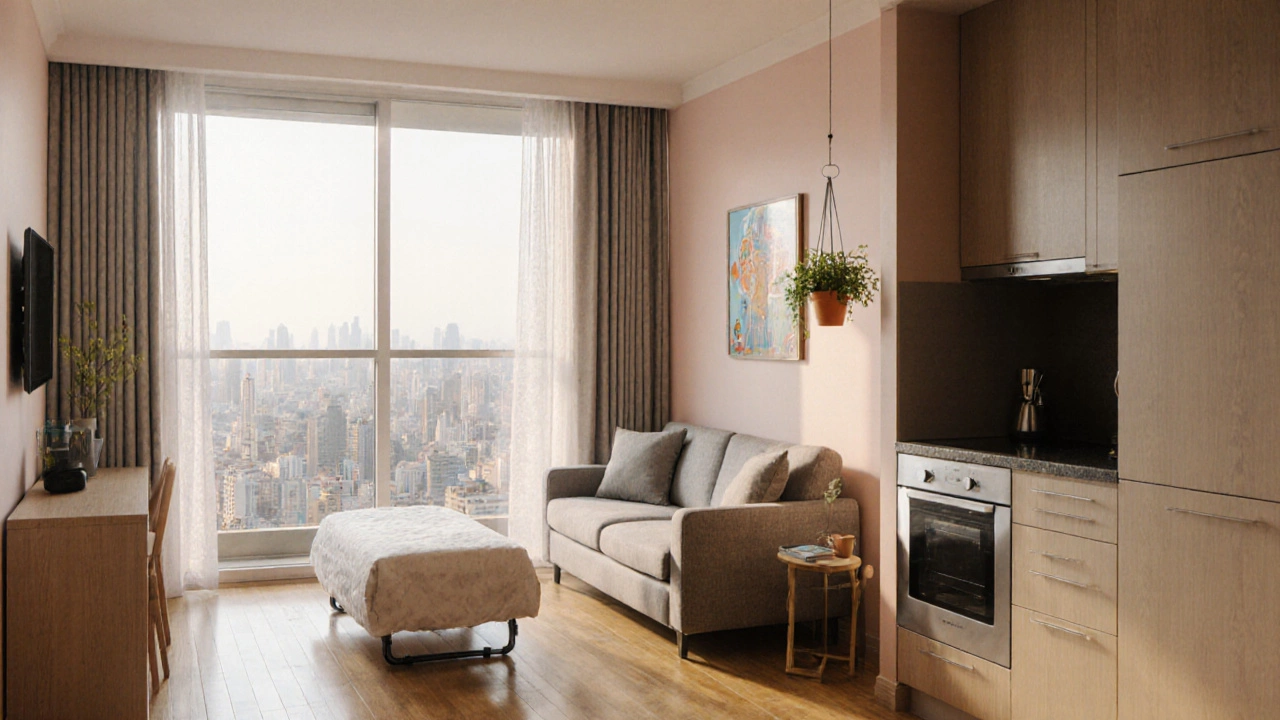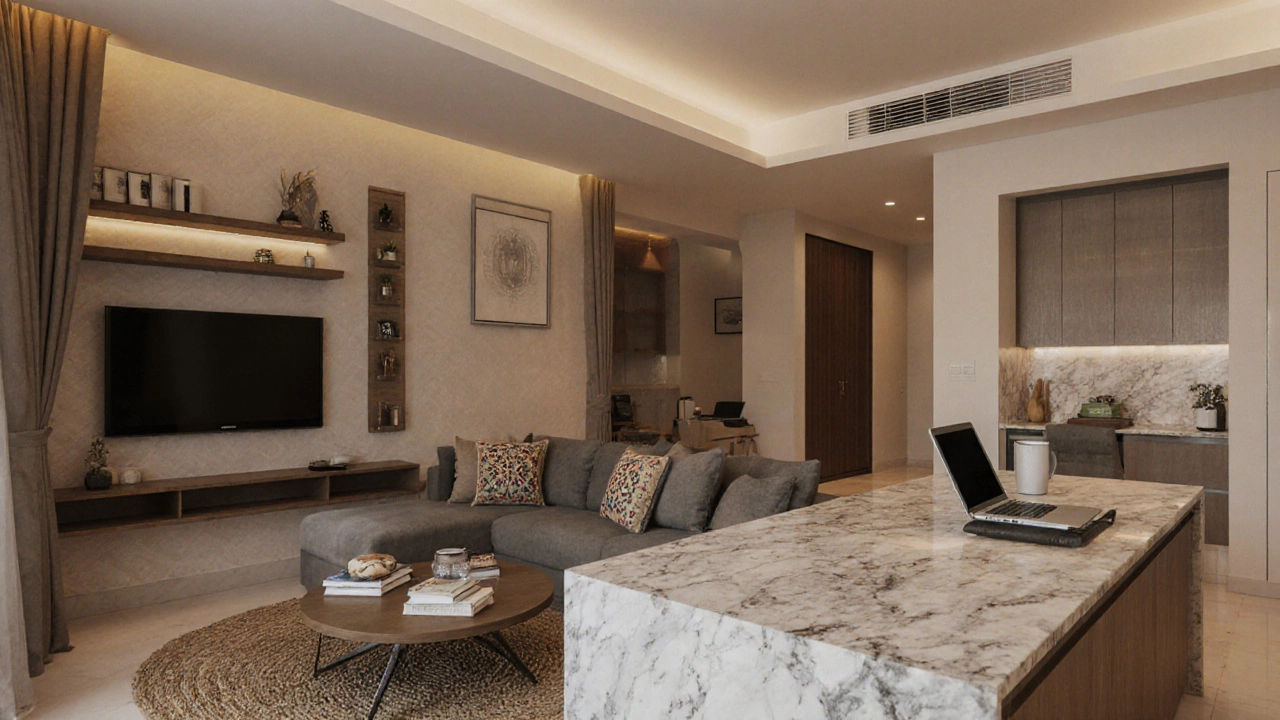Understanding T1 vs T2 Apartments: Size, Layout, and Renting Tips

Sep, 26 2025
T1 vs T2 Apartment Comparison Tool
Use this tool to compare T1 and T2 apartments based on your needs and preferences.
| Feature | T1 | T2 |
|---|---|---|
| Typical Size (m²) | 30-45 | 45-70 |
| Rooms | 1 (combined) | 2 (separate) |
| Kitchen Type | Open-plan or Kitchenette | Separate or Open-plan |
| Average Rent (LA) | $1,400-$1,800 | $1,800-$2,400 |
| Ideal For | Singles, couples, remote workers | Couples, small families, remote workers needing a study |
T1 apartment is a studio‑style unit that typically contains one main living area serving as bedroom, kitchen, and living space, usually ranging from 30‑45m². In many European and Asian markets the term "T1" is shorthand for "one‑room" (the "T" stands for "type"), and landlords use it to signal a compact, affordable option for singles or couples.
T2 apartment is a two‑room unit that separates the sleeping area from a distinct living room, often between 45‑70m². The extra room can be a dedicated bedroom, a study, or a small dining space, giving renters more flexibility without jumping to a full three‑bedroom layout.
How the Rental Market Classifies Units
In the broader Apartment market, classification systems help agents and portals standardize listings. Common categories include studio, T1, T2, T3, and so on. The classification ties directly to Housing classification rules used for tax assessments, financing, and sometimes rent‑control regulations.
Typical Size and Floor‑Plan Differences
| Attribute | T1 | T2 |
|---|---|---|
| Typical size (m²) | 30‑45 | 45‑70 |
| Number of separate rooms | 1 (combined living/bedroom) | 2 (living + bedroom) |
| Kitchen type | Open‑plan or kitchenette | Separate or open‑plan kitchen |
| Typical rent (LosAngeles) | $1,400‑$1,800 | $1,800‑$2,400 |
| Ideal for | Singles, couples, home‑office workers | Couples, small families, remote workers needing a study |
The numbers above reflect 2025 market data for the LosAngeles metro area, where rents have risen about 6% year‑over‑year. While the exact square footage varies by building, the pattern holds: a T2 gives you that extra room without the premium of a three‑bedroom unit.
Reading Listings: Spotting a T1 or T2
When you browse sites like Zillow or local French platforms, look for these clues:
- Keyword "T1" or "T2" in the title.
- Floor‑plan thumbnail showing one versus two labeled rectangles.
- Square‑meter range that matches the table above.
- Room‑count description (e.g., "1 bedroom + living room" usually signals a T2).
Agents often list the Floor plan as a PDF. If the document labels "Salon" and "Chambre" separately, you’re likely looking at a T2.
Pros and Cons of T1 Apartments
Pros:
- Lower rent and utility bills-good for tight budgets.
- Compact footprint makes cleaning quick.
- Often located on lower floors with easier elevator access.
- Ideal for remote workers who can fold a desk into the main room.
Cons:
- Limited separation between sleep and work, which can affect focus.
- Entertaining guests is cramped.
- Storage space is usually minimal; you may need extra units.

Pros and Cons of T2 Apartments
Pros:
- Dedicated bedroom improves privacy and sleep quality.
- Extra room can double as a home office or nursery.
- Better resale or sublet value if you ever move out.
Cons:
- Higher rent and often larger utility costs.
- May be located on higher floors where elevators are slower.
- Square footage increase isn’t always linear; sometimes you pay for a poorly‑used hallway.
Choosing the Right Unit for Your Lifestyle
Ask yourself three quick questions:
- Do you need a distinct space for work or study? If yes, lean toward a T2.
- Is rent a primary constraint? Then a T1 may free up cash for other priorities.
- How long do you plan to stay? For short‑term stays (under 12months) a T1 reduces commitment; for longer terms, a T2 can increase comfort.
Another factor is Lease term. Many landlords offer discounts for 12‑month leases on T2 units, while T1s often come with month‑to‑month flexibility.
Related Concepts to Explore
If you want to dig deeper, check out these neighboring topics:
- Studio apartment - similar to T1 but sometimes without a separate kitchenette.
- One‑bedroom apartment - often larger than a T1, with full kitchen and dedicated bedroom.
- Housing affordability - examines how rent levels impact different income brackets.
- Urban density - explains why compact units like T1s thrive in city cores.
- Rental incentives - such as free parking or reduced security deposits.
These concepts are part of the larger Real Estate knowledge cluster, linking back to subjects like commercial leasing, property registration, and affordable housing.
Practical Tips for Signing a Lease
Regardless of whether you pick a T1 or T2, follow these steps before you sign:
- Visit the unit at different times of day to gauge noise and natural light.
- Ask for a detailed Square meter breakdown to confirm the advertised size.
- Review the Lease term clause for early‑termination fees.
- Check for included utilities (water, trash, gas) - sometimes these are bundled in T1 rates.
- Request a copy of the building’s Homeowners Association (HOA) rules if you’ll share amenities.
Doing this homework can save you a few hundred dollars a month and avoid unpleasant surprises after you move in.
Frequently Asked Questions
What is the main difference between a T1 and a T2 apartment?
A T1 is a single‑room unit where the living, sleeping, and kitchen areas share one space, typically 30‑45m². A T2 adds a separate bedroom, giving you two distinct rooms and usually 45‑70m² of floor area.
Are T1 apartments suitable for remote work?
Yes, many renters set up a compact desk in the main room. However, if you need a quiet, dedicated space, a T2’s separate bedroom works better for concentration.
How do rents for T1 and T2 compare in LosAngeles?
In 2025, T1 units average $1,400‑$1,800 per month, while T2 units range from $1,800‑$2,400. Prices vary by neighborhood, building amenities, and lease length.
Can I negotiate the rent on a T2 apartment?
Negotiation is common, especially if you sign a longer lease or have a strong credit profile. Landlords may also offer a month of free rent or reduced security deposit as incentives.
What should I check in the lease before moving into a T1?
Look for clauses about utility inclusion, early‑termination penalties, subletting rules, and any restrictions on modifications (like adding a shelving unit). Also verify the exact square‑meter measurement.
Is furniture typically included in T1/T2 rentals?
Most unfurnished rentals do not include furniture, but many owners offer partially furnished options (bed, sofa, dining table) for an extra monthly fee. Check the lease addendum for inventory lists.
Do T1 apartments have separate bathrooms?
Yes, even the smallest T1 units have a dedicated bathroom. The layout may place it near the kitchen or at the back of the unit, but it remains a distinct space.